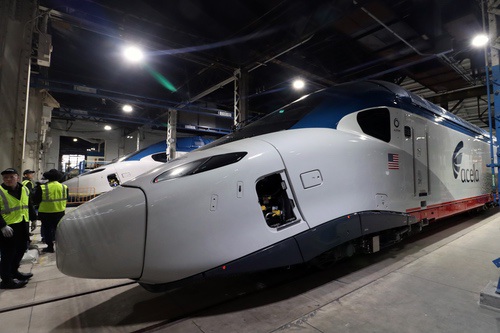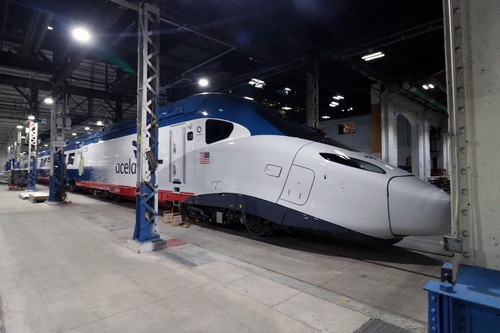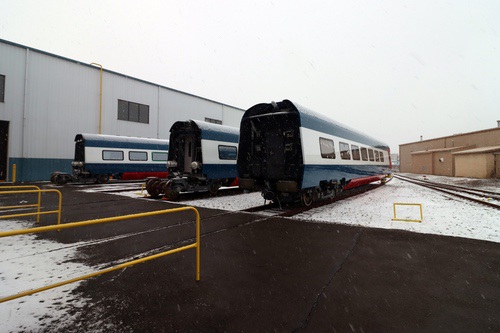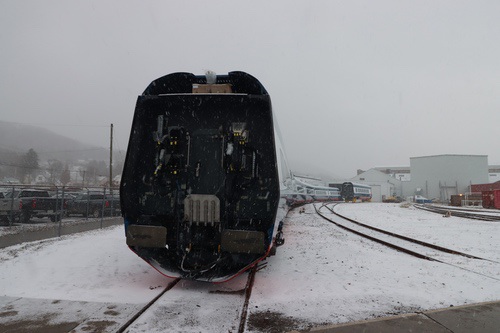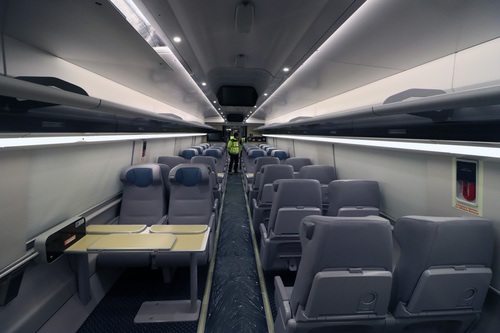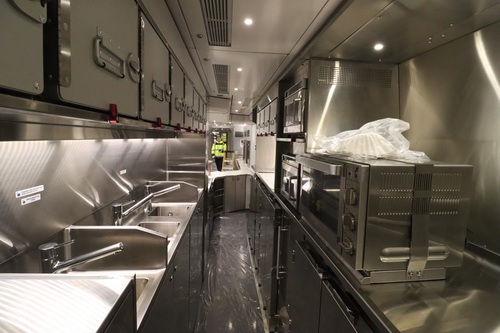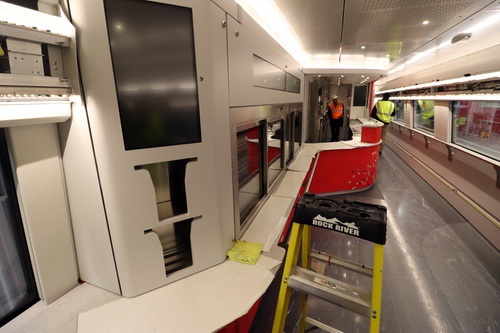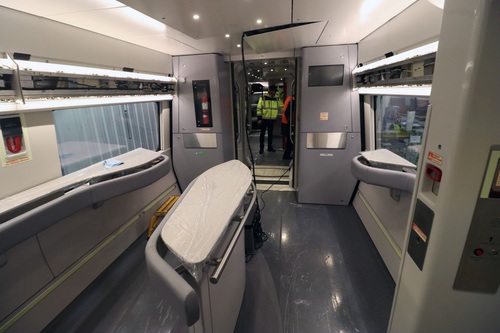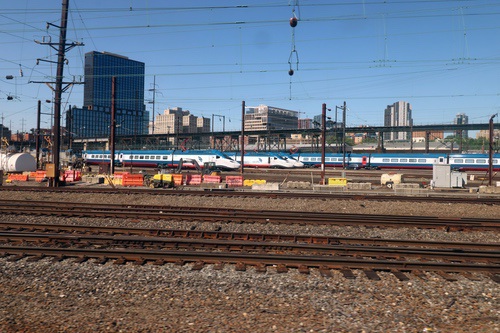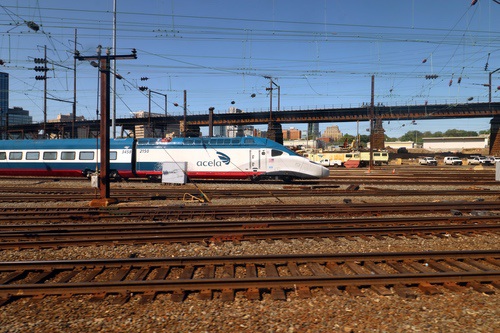Acela Express
on the SubwayNut
·Boston, MA - Back Bay Station
·Route 128, MA
·Providence, RI
·New Haven, CT - Union Station,
·Stamford, CT
·New York, NY - Penn Station
·Newark, NJ - Penn Station
·Metropark, NJ
·Philadelphia, PA -30 St Station
·Wilmington, DE
·Baltimore, MD - Penn Station
·BWI Airport, MD
·Washigton, DC-Union Station
Amtrak's Acela Express is Amtrak's premium higher speed service. The train line operates exclusively along the Northeast Corridor between Washington, DC and Boston via New York City and Philadelphia. Trains use unique high-speed trainsets based on the famous French TGV, although all the cars are significantly heavier to meet US crash test standards. The train cars include active tilting technology since Acela Express operates on an existing over 100-year-old railroad corridor and not dedicated newly built high-speed lines. As part of the introduction of the Acela Express, the line from New Haven north to Boston was finally electrified. This project was more than eighty years in the making since electrification was extended from New York City to New Haven in 1914.
The new Acela Express train service debuted in December 2000 with brand-new trains. Acela trainsets contain two power cars (one on each end), 1 First Class Car plus 4 Acela Business Cars with "CafeAcela" in the middle between them. The Acela Cars are also unique because they can only stop at high-level platforms with level boarding. The trains lack steps and traps for low-level platforms. This delayed their ability to have any trains stop at New London, Connecticut in particular until high-level platforms were added in 2001, although all service to New London was discontinued in 2023.
The service on Acela includes complementary at seat meal service, and unlimited alcoholic beverages in Acela First. The CafeAcela is designed to be “bistro-style.” With no conventional tables and just tiny stools to sit down and eat at. When Acela was first introduced, CafeAcela included very year 2000 premium features like draft beer and a TV showing CNN in the cafe car. These features are both long gone. There are no free non-alcoholic drinks in Business class like Business Class on other Amtrak route. At seat cart service has been experimented with on Acela over the years (supplementing the cafe car) with either drinks and snacks for purchase or including free drinks and snacks on a couple of non-stop Acela trips between Washington, DC and New York City just before the COVID-19 pandemic. At seat service is currently offered on some Acela trains as of January 2025.
As of January 2025, the line operates along the entire length of the electrified Northeast Corridor with 11 trains per day on weekdays on the core of the route between Washington and New York City. 8 of these trains are extended north to Boston, plus one just New York to Boston only round-trip (the first train of the day to leave New York, the last train of the day to leave Boston). Saturday service is reduced to just 6 Washington to New York trips, with 4 extended to Boston. Sunday service is nearly the same as weekdays with 8 round-trips from Washington to Boston, and 10 between Washington and New York.
Amtrak's goal is to normally run service hourly on weekdays between New York and Washington, DC. The current reductions in service are because multiple Acela trainsets have already been mothballed or cannibalized to help keep the remaining trainsets in service. Although the ride is longer from New York to Boston generally fares are cheaper to Boston than Washington, DC due to less demand, and the train taking longer averaging 82 mph from Washington to New York, and just 66 mph from New York to Boston.
Trains originally only reached their highest speeds of 150 mph in a tiny section of Massachusetts and Rhode Island, but this high-speed section is offset by the slow speeds along non-Amtrak owned Metro-North and CTDOT stretch of the corridor between New Rochelle and New Haven. Upgrades were finally made in 2020 to allow the same 150 mph Acela speeds between Trenton and New Brunswick along the "New Jersey Speedway".
The line isn't the first premium service to target business travelers to operate along the Northeast Corridor. Acela is the direct predecessor of the Metroliner that operated primarily between New York and Washington DC starting in January 16, 1969 under Penn Central before Amtrak took over operations with its creation in 1961. The line originally used EMU self-propelled railcars until the early-1980s. Issues with EMU cars resulted in the Metroliner using conventional Amfleet I cars (based on the same carbody design as the original Metroliner cars) hauled by AEM7 locomotives. The longevity of these stainless-steel car bodies resulted in some of these cars being rebuilt into cab control cars for push-pull operations and today operate on Keystone Services along with the Valley Flyer and Hartford-Springfield Shuttle.
The final Metroliner trains on the outside looked basically the same as conventional Northeast Regional and other single-level trains in the Northeast. Then interiors of the Metroliners were specifically retrofitted for this service. Metroliner Business cars had more legroom and curtains (like today's full length business class cars on the Northeast Regional and other trains). Metroliner First Class saw a train with seating in a 2 x 1 configuration around a central cafe car set-up. This cafe car set-up provided First Class service with at seat meal service just like Acela First Class today. These ex-Metroliner Cafe cars were later modified into the current split cafe/business class cars we see today. The super comfortable 2 x 1 seating are the same seats as what was operated in first class on the Metroliners. These cars operate on shorter single-level state-supported routes including the Empire Service, Vermonter, Ethan Allen Express, Downeaster, Maple Leaf, along with some Illinois and Michigan routes in the Midwest that don't operate with a Horizon Cafe/Club car in the same configuration.
New Acela Trainsets are coming soon with 28 new Avela Liberty trainsets nearly completing construction by Alstom in Hornell, New York. Final assembly on these cars, based on the TGV M model, will completely replace the current Acela trainsets. The current Acela trainsets are extremely overweight because of US crash standards, and it was seen as more economical to buy entirely new trainsets to increase capacity instead of purchase one-off cars. The new trainsets will have 9 passenger cars (and two power cars). The same First Class car as today, plus a cafe car and 7 Business Class Coaches. I had the pleasure of going on a tour of the Alstom factory in December 2024 and some photos are below:
The new cars are currently visible in storage just north of Philadelphia-30th Street Station and the facility in Hornell has some visible from public streets. I also got to walk through the interior of the new cars. They are modern with winged headrests. On the tour I unfortunately couldn't sit down in any of the seats. First class is in a 2 by 1 configuration like today, with Acela Business in a 2 by 2 configuration. The biggest difference is the cafe car. It has been retrofitted with no seating and has tables for standing only, like on the TGV. To me this brings up ableism issues. I'm also curious where Amtrak crews will sit. I was told the crews would have an office, but I know how seldom used these little office compartments are on single-level trains so it will be interesting how these work out in day-to-day operations. Acela cafe cars are also used by commuting employees so it will be interesting to see how this plays out. Here are some interior photos (covered in plastic):
As of May 2025 Most of the new Acela Trains are sitting outside of 30th Street Station, visible from passing trains:
The new Acela Express trainsets should debut sometime in 2025.
